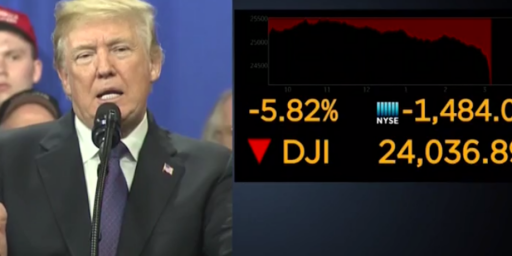Real Estate Bubble Economy?
U. S. News has a fascinating feature article entitled, “The red-hot housing market reminds some of the latter days of the 1990s stock market. How will it end?”
After one of the broadest and longest run-ups in housing prices ever, most homeowners are sitting pretty. But there is a growing angst about how much longer the party can go on. Those who believe housing is now the new “bubble,” much like the ’90s stock market, point to slowing sales and rising interest rates amid nosebleed prices that have far outpaced growth in personal income. Take Las Vegas, for example, where the median home price has increased an eye-popping 54 percent in the past 12 months alone.
And while much of the middle of the country has enjoyed far more modest gains, red-hot coastal markets in California and the Boston-to-Washington, D.C., corridor, as well as in southeast Florida, have pushed up the national median sales price by more than 7 percent in the past year, three times faster than household income.
*** In cocktail party chatter reminiscent of the days when housewives and taxi drivers confidently traded stock tips, many have oversimplified the real-estate market’s underlying fundamentals, Shiller believes. “The typical simplistic view is that it’s just supply and demand,” he says. “That where they live is such a wonderful place and that since there isn’t enough land for everyone, prices have nowhere to go but up.”
In truth, sprawling housing developments across the country attest to the housing industry’s ability to readily supply the demand, and then some. Last year alone, America’s builders started construction on about 2 million homes, nearly twice the number of households the country added. Meanwhile, growth of so-called exurbs in outlying areas demonstrates Americans’ willingness to commute more than 50 miles one way to buy where prices are more affordable. Even in crowded places like Miami, a building boom that has transformed once moribund inner-city neighborhoods into massive construction zones is expected to add 25,000 condos in the next year and a half–about five times the number sold last year.
*** [A] lack of available housing didn’t stop real-estate prices from plummeting there amid the economic downturn that followed the 1987 stock market crash. That’s when Sheryl Lieberman bought her first apartment in Manhattan for $230,000. Six years later, a friend in the same building sold a similar apartment. “It was two flights higher, so it should have been worth more than my place. But she only got $160,000,” recalls the 45-year-old financial adviser. “People forget that what goes up can also come down. Like right now, they think real estate can’t fail. I heard the same thing in the early 1980s, and then came the late 1980s.”
I would note that home prices are far higher in most areas now than they were in the 1980s, even adjusted for inflation. Certainly, a massive increase in interest rates could make the current prices unsustainable in the short term, making people forced to sell their home take a loss on their investment. Those of us with variable rate mortgages could also be squeezed. However, real estate prices in major metropolitan areas will certainly only go up in the long term.
While supply and demand aren’t the only factors affecting home prices, they’re by far the most significant component. I live in the D.C. exurbs of Loudoun County. While I’m only 30 miles or so from downtown D.C., that’s still over an hour of driving each way during the morning and evening rush hours–and getting worse by the month. While there are people who manage daily commutes from as far away as West Virginia and Pennsylvania, the numbers willing to spend five hours a day commuting has to be miniscule. Housing that’s closer to the city will therefore always be at a premium.






The one difference is that although they’re making more stock they’re not making any more real estate. And a house in the fashionable suburbs will continue to have some value and be a status symbol even if Amazon stock doesn’t and isn’t.
There’s a more important constraining factor: incomes. The price of real estate cannot, over the long term, increase by much more than incomes do, no matter how much demand goes up.
I’ve been expecting real estate to “bubble out” in California for years. Demand has been increasing while the upper limits of supply (actual real estate, which is fixed, is not the same as marketable real estate, which can be increased or diminished, within limits — and the latter is what matters) have been diminishing due to unreasonable environmental regulation.
No bust yet. [knocks on wood]
I think there will be an adjustment here next year or two–a slight settling. But the long-term trend will always be up, so the biggest mistake one can make is not buying during a peak: rather, it’s not buying at all.
I think cities will see renewed demand, as people start to value shorter commutes over homes in “fashionable” suburbs (the nature of fashion is that it waxes and wanes, no?). But if your home is in or near a city that continues to produce jobs, it isn’t going to lose too much of its value.
You can always make more real estate. Subdivisions break up larger parcels for development, multi-family homes and condos replace single family homes. Even in the city, old industrial buildings are rehabilitated or demolished for housing projects.
One thing to remember about property values though, is that low interest rates have had people in the last two years buying well beyond what they can afford. When the cost of living rises, including energy prices, taxes, and upkeep of those expensive houses, something will have to break.
Another trend to consider is that some people flock from the cities once their nest egg is earned, to live a slower and more affordable life in the burbs or country. Crime and terrorism may yet have further impact on those metro property values.